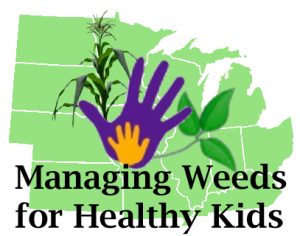Andrew Kniss is a professor at the University Wyoming whose research is partially funded by the pesticide and biotech industry. My research over the last ~15 years has been substantially funded by organic food companies, and foundations that hope to support bio-based innovation in agriculture that leads to healthier food and a lighter environmental footprint. (For much more on funding sources and their impacts, see the section on “Funding and Sound Science,” which includes information on Hygeia Analytics funding).
Dr. Kniss and I have carried out research for many years on the impacts of GE crops on pesticide use. I consider him one of my more data-driven and enlightened critics, but I am also not shy about critiquing his work in the same spirit he critiques mine.
Andrew’s latest contribution to the debate over GE-crop-pesticide impacts appears in Nature Communications, released online April 10, 2017, and is entitled “Long-term trends in the intensity and relative toxicity of herbicide use”. It is available free of charge and is essential reading for those tracking the debate over the impact of GE crops on pesticide use a topic covered elsewhere on Hygeia Analytics.

The purpose of the Kniss paper, as I read it, is to put a happier face on sharply upward trends in herbicide use on GE crops, and the collateral damage pilling up in the wake of the breakdown of Roundup Ready based, herbicide-resistant crop technology. It’s a tough job, but Dr. Kniss is among the academics willing to take it on.
His paper reaches two basic conclusions. First, herbicide use intensity, as measured by acre-treatments (he calls them “area-treatments”), has risen about as fast in three non-GE crops (rice, spring wheat, winter wheat) as they have on the three major GE crops (corn, soybeans, and cotton).
Second, the “relative toxicity” of herbicide use has not dramatically changed in the GE crops, compared to the non-GE crops.
I mostly agree with his first conclusion. I work with the same herbicide use data and concepts, and adhere to the same principles of mathematics as Dr. Kniss. But I disagree with some of his assertions regarding why, and the relevance of comparing the three major GE crops to three non-GE crops. To fully explain why would drag the reader deep into the weeds, so I leave that for another time and place.
I mostly disagree with his conclusions regarding herbicide toxicity trends. His analysis is methodologically flawed and does not support the conclusions he draws from it. It is hard to imagine how this paper made it through Nature Communication’s usually rigorous peer-review process; not a single reviewer raised any foundational issues with Kniss’s toxicity metrics (the reviews are accessible in the supplemental material on the Kniss paper). He presents pretty graphs and figures showing trends in acute and chronic toxicity units by crop over time, but his analysis fails to consider changes in exposure.
Especially in the case of herbicides, use does not equal exposure. Indeed, GE crops have dramatically increased herbicide exposure profiles, because of the very nature of the technology. As the graphic below illustrates, GE-herbicide resistant (HR) technology extends the time-period during which herbicides can be applied over the top of growing crops. This shortens the pre-harvest interval between the last spray and harvest, thereby dramatically increasing the frequency and levels of residues in grain at harvest.
In addition, in the case of GE-HR crops, herbicides are applied directly on maturing crops rather than on the soil before or at planting. There are virtually zero herbicide residues in food at harvest when herbicides are applied before planting, at planting, or in the first month following plant germination.

By ignoring changes in exposure over time and by herbicide, Kniss creates a metric well designed to prove the point he hoped to drive home through his analysis and paper.
Kniss also does not mention widely available biomonitoring data that show rising levels and frequency of 2,4-D and glyphosate in the urine of Americans (CDC, 2013; CDC, 2015; Adams et al., 2016), nor does he point out that soon most people living in the Midwest will have residues of at least four corn-soybean herbicides in their urine on a near-daily basis from spring through the fall – 2,4-D, glyphosate, dicamba, and atrazine – and probably two of these year-round.
Because of the ancient vintage (circa 1980s) of the toxicology studies supporting contemporary uses of the above four herbicides, and growing evidence of possibly serious epigenetic, reproductive, and developmental risks from low-dose herbicide exposures in the first trimester of pregnancy, there is no way to accurately project human health risks.
But one thing is certain – herbicide use and exposures began rising in the mid-2000s, driven by the need to spray additional herbicide active ingredients, and more herbicides overall on fields infested with glyphosate resistant weeds (Benbrook, 2016). As a result, human risks have been rising in step with exposures since the mid-2000s, and are, unfortunately, about to rise much more sharply because of the dramatic increases in 2,4-D and dicamba use.
There are several things Kniss and I agree on:
- Pounds of herbicide active ingredient applied, overall or per acre, is an incomplete metric of herbicide use, and if used in isolation, can be misleading;
- Herbicide acre treatments, especially the average number of acre-treatments per acre planted, is an important metric, but still incomplete if used in isolation; and
- The Environmental Impact Quotient (EIQ) method of translating pesticide use to relative risks is flawed and unreliable (a point widely agreed upon nearly 20 years ago).

But the messages that Kniss is trying to convey – that GE, herbicide-resistant crops have not changed herbicide use significantly, and that relative risks have not risen, and maybe have declined – are not supported by Kniss’s analysis and are flat wrong in the case of recent and unfolding herbicide use in corn-soybean country.
All his tables and analyses stop in crop year 2014, missing the last two years of increases in herbicide use intensity, as well as the transition to more toxic herbicides. About 4 million acres of soybeans were planted in 2016 to new, dicamba-tolerant seeds and sprayed with dicamba, an old-school, high-risk herbicide that causes reproductive problems and birth defects, and is highly volatile.
This later property of dicamba leads to volatilization, especially in hot, humid summer conditions, and movement across the landscape. When it rains or is foggy, the dicamba descends back down to earth. When it lands on plants, trees, and vines, bad things often happen. A wide variety of popular garden vegetables, fruit crops, and vines are highly susceptible to dicamba, and will suffer serious damage, especially when drifting dicamba lands on plants and tress when they are setting fruit. Ditto, soybeans lacking the dicamba-resistance gene.
In 2016, thousands of farmers and rural residents got a taste of what is coming in crop season 2017, a year when there will be around 15 million acres planted to dicamba-resistant soybeans (Monsanto projection provided to USDA).
The same dramatic increase in herbicide use intensity and risks is unfolding in corn. Dow AgroSciences and DuPont/Pioneer have won approval of 2,4-D resistant corn. Dow’s new EnlistDuo herbicide contains both glyphosate and 2,4-D. New corn hybrids with the 2,4-D trait are also genetically engineered to resist glyphosate and the “fop” family of herbicides. Overall use rates will rise about 50%, acre-treatments will likewise rise at least 30%, as will farmer seed costs.
Like its phenoxy herbicide cousin, 2,4-D is also highly volatile. Over the last decade, 2,4-D has caused more cases of herbicide drift and crop/plant damage leading to state enforcement actions than any other herbicide.
In 2017, Dow AgroSciences projects that about 13.5 million acres will be planted to 2,4-D resistant corn seed. In addition, about 15 million acres will be planted to newly approved, 2,4-D resistant soybeans, and another about 8 million acres of soybeans not containing the 2,4-D resistance trait will be sprayed with 2,4-D.
Accordingly, over the next four months this year, close to 40 million acres will be sprayed with 2,4-D or dicamba in corn and soybean country. Moreover, herbicide application rates will more than double, on average, and more applications will be made per acre. More herbicide, sprayed later in the season, will markedly increase both environmental and human health risks.
Given all the factors changing at once, there is need for one herbicide use metric that encompasses them all, and pounds applied is as good as any, despite its flaws. In 2015, farmers sprayed about 13 million pounds of 2,4-D and dicamba on corn and soybean crops, and in 2017 they will spray around 65 million pounds, more than a 4-fold increase.
Volatilization drift of 2,4-D and dicamba will likely cause unprecedented levels of plant and crop damage in 2017, and trigger thousands of conflicts among farmers and rural neighbors, some of which will wind up in court. State departments of agriculture are bracing for a summer of discontent.
But the only passage in Kniss’s April 2017 paper that remotely acknowledges these facts reads:
“In some cases, more recent trends may be important even when the overall trend [in herbicide risk] is non-significant.”
New Project Tackles Herbicide-Birth Outcome Linkages

A new project focused on the link between rising herbicide use in the Midwest and adverse birth outcomes was launched April 7, 2017 in D.C., at a pediatric research conference sponsored by the Children’s Environmental Health Network (CEHN). I serve on the project’s science team.
The project’s website contains detailed information on herbicide use metrics, and the lengthy discussion of the need for 18 herbicide-use metrics makes many of the same points as the Kniss paper.
Dozens of tables are posted reporting USDA data on herbicide use over time, nationally and in the seven major Midwestern states that account for most corn and soybean production and herbicide use. Dozens more tables report trends in herbicide use over the last 30 years. For those with a taste for the weeds, dive in and explore these tables. More detailed analyses, including trends in the toxicity of herbicide use, will be posted in the months ahead.
From many years of work in this area, two conclusions stand out to me as incredibly important and indisputable. First, something meaningful must be done, and soon, to slow the spread of weeds resistant to widely used herbicides, or the herbicide treadmill (which Kniss acknowledges) will start driving U.S. corn and soybean farmers off a fiscal and weed management cliff.
Second, the rapid shift to high-risk herbicides in corn-soybean country poses a serious threat to pregnant women, infants, and children, and demands a systematic and thoughtful response from farmers, their organizations, state and federal government agencies, and the private sector.
The CEHN herbicide project website contains a section entitled “How to Reduce Risks.” It highlights essential steps in constructing a broad-based, systematic campaign to change weed management systems in the nation’s Heartland.
Despite the compelling need for change, it is hard to imagine where the impetus will come from. The message advanced in the newly published paper in Nature Communications will not help. It will be widely cited by those content with the status quo and unconcerned about trends in herbicide use and risk.
Sources:
Andrew Kniss, “Long-term trends in the intensity and relative toxicity of herbicide use,” Nature Communications, published online April 10, 2017.
References:
Adams, A, Friesen, M, Olson, A, Gerona, R. “Biomonitoring of glyphosate across the United States in urine and tap water using high-fidelity LC-MS/MS method,” 2016. Poster presentation, access at: http://cehn-healthykids.org/wp-content/uploads/2017/02/APAMT-Poster-Gerona.pdf.
Charles M. Benbrook, “Trends in glyphosate herbicide use in the United States and globally,” Environmental Sciences Europe, 2016, 28:3, DOI 10.1186/s12302-016-0070-0.
Centers for Disease Control, “Fourth national report on human exposure to environmental chemicals: Updated tables, September 2012,” 2013, U.S. Dept. Health Human Services, available at: https://www.cdc.gov/exposurereport/pdf/FourthReport_UpdatedTables_Sep2012.pdf
Centers for Disease Control, “Fourth national report on human exposure to environmental chemicals: Updated tables, February 2015,” 2015, U.S. Dept. Health Human Services, available at: https://www.cdc.gov/biomonitoring/pdf/fourthreport_updatedtables_feb2015.pdf

